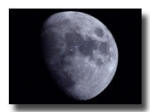
As the moon circles our planet, its gravitational pull tugs and stretches the soil. It creates high and low tides in all the water on Earth, including the dew that surrounds sprouting seedlings.
Countless books have been written advocating planting based upon the phases of the moon. Scientists have been studying the moon's effect on plants. On one university campus, researchers charted the electro-dynamic fields in trees. These researchers found cycles that related to moon activity. At the USDA Agricultural Research Service National Laboratory in Ames, Iowa a study showed that farmland tilled on moonless nights experienced dramatic drops in weed seed germination.
Here are some general guidelines for moon gardeners:
| |
The Decreasing Moon |
 |
The period from the full moon to the new moon is called a waning moon. This decreasing period is said to be the best time for pruning, weeding, cultivating, harvesting, and planting perennials and seeds that bear their crop below the ground. This includes root vegetables like potatoes, radishes, carrots and turnips. |
| |
The Increasing Moon |
 |
The period from the new moon to the full moon is a waxing moon. The best time to plant the seeds of above-the-ground annual crops is when the moon's light is increasing. This includes leafy salad greens, cabbage family members, and vine crops. An increasing moon is also the ideal time to move or add plants. |
| |
The Dark Moon |
 |
The period between waning and waxing is called the dark moon, or new moon. Propagation is best done when the dark moon is just starting to grow. Late evening during this phase of the moon is a good time to turn over the soil. |
| |
The Full Moon |
 |
The moon is considered full when the entire sunlit side of the moon is visible. This is the best time to enjoy night blooming flowers and to sow seeds that need light to germinate. |
- Laara Duggan